Introduction: In this article, Melissa Davenport Berry continues to pay tribute to Queen Elizabeth II’s lifelong love for her corgi dogs. Melissa is a genealogist who has a blog, AnceStory Archives, and a Facebook group, New England Family Genealogy and History.
From a young age Queen Elizabeth II had a deep love for corgi dogs. Her father King George VI brought home the first corgi, “Dookie,” in 1933.
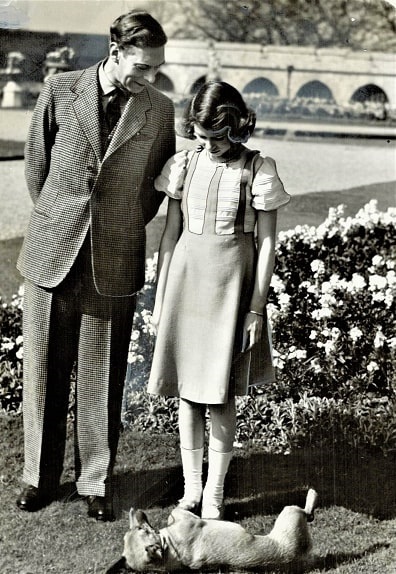
Queen Elizabeth (wife of King George VI) adored the breed and soon the whole royal family had their own corgi.
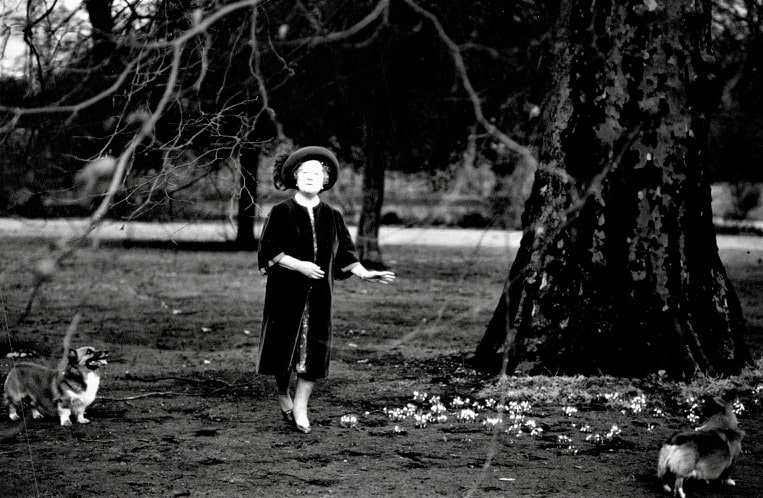
On her 18th birthday Elizabeth’s father gave her Susan, a Pembroke Welsh Corgi, who is the common ancestor of all the Queen’s royal corgis.
These majestic dogs got quite the rep for nipping the royal staffers (see: Queen Elizabeth II and Her Beloved Court Corgis).
Pembroke Welsh Corgis are considered magical creatures. According to legend, they work with farmers during the day and go to the woods at night to become steeds for fairies.
There is no doubt magic was bred into all the Queen’s corgis. In England the corgi breed grew in popularity, and the Queen had a hand in saving Pembroke Welsh Corgis from extinction.
That magic made its way across the Atlantic. Here are a few stories.
In 1968 the News and Courier reported on a South Carolina family and their corgi.

This article reported:
Buckingham Palace, home of Britain’s Queen Elizabeth II, and 14 25th Avenue, Isle of Palms, home of Mr. and Mrs. Herbert M. Burn Jr., now have something in common.
The Burns recently bought a Welsh Corgi, a pup by the name of Swamp Fox Henrietta who can boast champions in her pedigree.
But when the Burns’ learned the tail-less corgi is the favorite pet of Queen Elizabeth, they decided to name their own pup after the monarch’s. They wondered what exalted name that would be, and wrote to Buckingham Palace to find out.
The queen’s reply, directed through a lady-in-waiting, arrived at the Isle of Palms post office last Friday.
Lady Rose Baring informed the high school teacher and his wife: “I am commanded by the Queen to thank you for your letter and to tell you that the names of Her Majesty’s present corgis are Heather, Buzz, and Tiny.”
“We ruled out Buzz and Tiny. They hardly sound like regal names,” Mrs. Burn said yesterday.
So Swamp Fox Henrietta, proud pup of Naidila’s Faro and Swamp Fox Red Devil, will be rechristened Heather – with official approval of the American Kennel Club.
Henrietta’s own reaction is not known. She has no tail to wag or droop.
Breeding, mixed with genealogical history, go hand and hand. Many of the American corgi owners descend from Jamestown, Virginia. Queen Elizabeth II’s ancestors also have ties (see links below).
In 1950 Mrs. James Moreland Whitefield was featured in the Richmond Times-Dispatch with her Welsh Corgi, Sir Daniel Pepcorn.
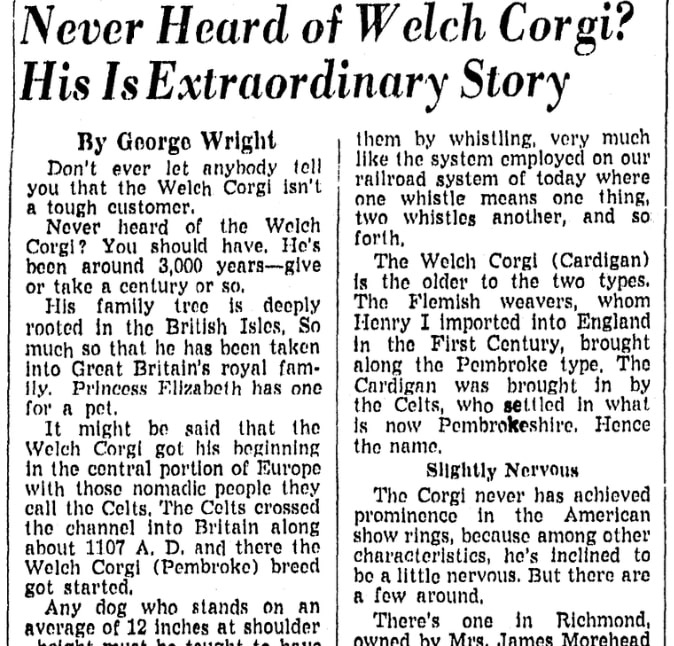
She served up quite a history on Sir Daniel and his lot, who have been around a good 3,000 years!
Here are a few snippets she shared in this article:
His [corgis’] family tree is deeply rooted in the British Isles. So much so that he has been taken into Great Britain’s royal family. Princess Elizabeth has one for a pet [the infamous Susan].
It might be said that the Welsh Corgi got his beginning in the central portion of Europe with those nomadic people they call the Celts. The Celts crossed the channel into Britain along about 1107 [B.C.] and there the Welsh Corgi (Pembroke) breed got started.
Any dog who stands on an average of 12 inches at shoulder height must be tough to have gotten along all these years.
The Celts, it seems, employed these members of what is now called the “Working Group” [a category for dog shows] as cattle dogs. The corgis were too light for heavy work and too heavy for light work. So, they made them cattle dogs.
The stories say that the corgis liked their work, too. They used to nip at the shanks of the cattle on the farms of the Welsh tenant-farmers (or “crofters”) and then drop to prevent being kicked by one of the suddenly irritated cows. They got so good at their work that the farmers used to control them by whistling. [Perhaps Buckingham Palace guards could have taken a cue from this history when Susan and her descendants nipped them.]
Mrs. Whitefield, born Catherine Gibbs, and her husband descend from Jamestown’s Thomas Gascoigne, Thomas Horton, John Taylor, William Pierce, and Jeremiah Clements.
Did any corgis romp around the Jamestown settlement? You never know. (Read Jamestown Rediscovery-Dog Bones.)
Mrs. Charles Waldo Daniels, born Laura Elizabeth Arnold, had her own court of Welsh Corgis in Mississippi. Their photo was in the Atlanta Journal in 1966.
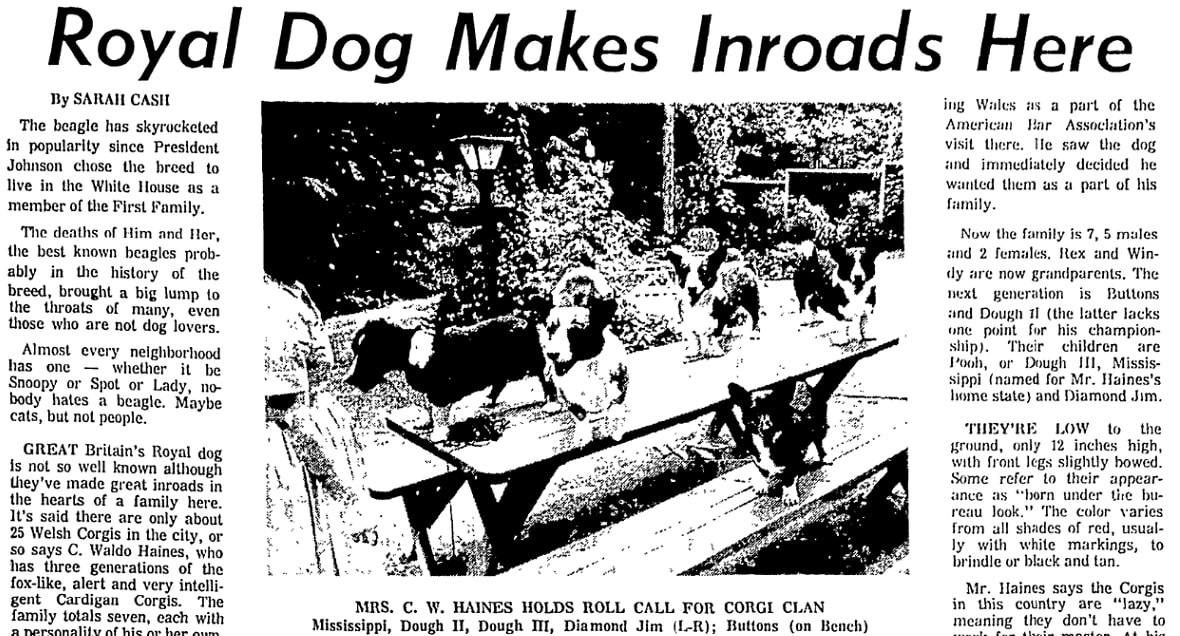
The Haines’ chose the Cardigan Welsh breed and purchased them in 1957 while on a trip to Wales. The newspaper article noted this canine was the royal choice as well:
Whenever there is a photo of the Queen’s family, whether it be Queen Elizabeth, Princess Margaret, Princess Ann, or any of the cousins, there is usually a Pembroke Corgi about.
Like the palace pooches, the Haines’ corgis are spoiled: air-conditioned rooms, well-planned and well-balanced meals, with snacks in between like livered-flavored biscuits.
Also in line with the royals, Mrs. Haines emulated their careful breeding and colorful names:
Now the family is 7, 5 males and 2 females. Rex and Windy are now grandparents. The next generation is Buttons and Dough II. Their children are Pooh, or Dough III, Mississippi, and Diamond Jim.
The Haines’ descend from Jamestown’s William Anderson, John Rose, Robert Booth, John Harvey, John Rose, and John Davenport.
In 1974 Louis and Carolyn Snidow made headlines with their champion Pembroke Welsh Corgi, Wyeford Buffalo Bill.
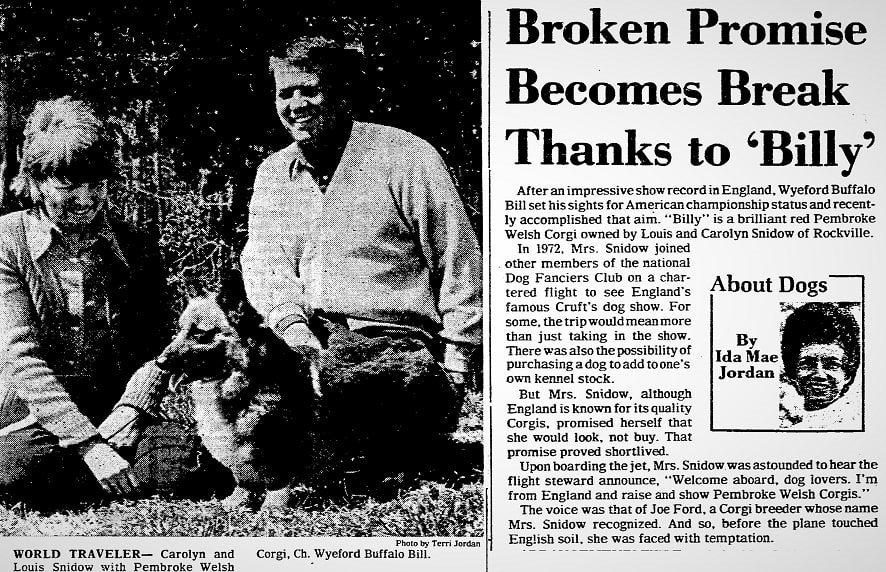
The Snidow’s operated the Mickleknox Dog Boarding Kennel in Rockville, Virginia. Mrs. Snidow told the press she promised herself never to purchase an English corgi, but when traveling there in 1972 with the National Dog Fancier Club she had a divine intervention on the plane trip over.
Here is the scoop:
Upon boarding the jet, Mrs. Snidow was astounded to hear the flight steward announce, “Welcome aboard, dog lovers. I’m from England and raise and show Pembroke Welsh Corgis.”
The voice was that of Joe Ford, a corgi breeder whose name Mrs. Snidow recognized. And so, before the plane touched English soil, she was faced with temptation.
She visited the Ford Kennels, just to look, but spotted Billy and could not resist taking him home. The rest was history.
The Snidow’s descend from Jamestown’s George Taylor, Richard Marshall, William Fitzhugh, Abraham Iverson, John Browne, Thomas Gascoigne, Isabella Freeman, and Richard Cocke.
Stay tuned for more on Jamestown descendants!
Note: An online collection of newspapers, such as GenealogyBank’s Historical Newspaper Archives, is not only a great way to learn about the lives of your ancestors – the old newspaper articles also help you understand history and the times your ancestors lived in, and the news they talked about and read in their local papers.
Note on the header image: a photo of Queen Elizabeth II accompanied by two of her sons, Princes Andrew (10) and Edward (6), two of the royal corgis, and unidentified palace officials. Wichita Falls Record-News (Wichita Falls, Texas), 31 December 1970, page 9.
Related Articles:
